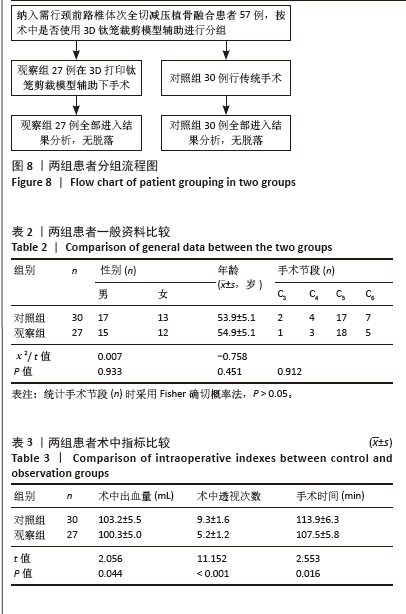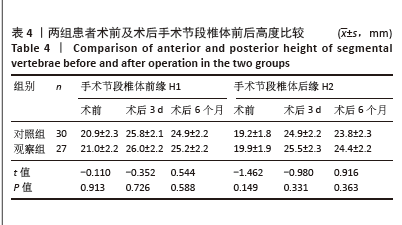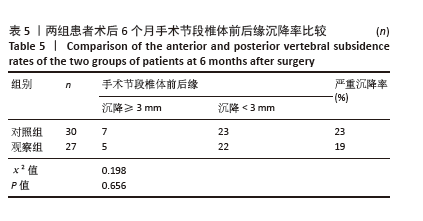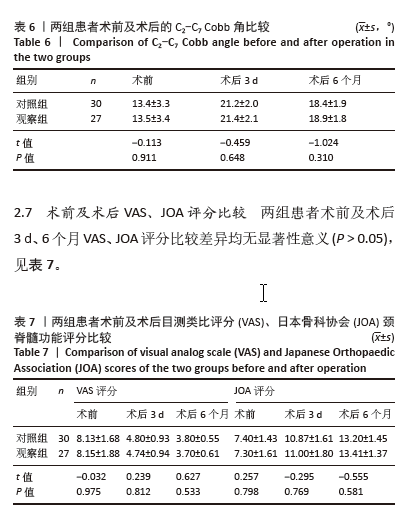[1] IYER A, AZAD TD, THARIN S. Cervical Spondylotic Myelopathy. Clin Spine Surg. 2016;29(10):408-414.
[2] MCCORMICK JR, SAMA AJ, SCHILLER NC, et al. Cervical Spondylotic Myelopathy: A Guide to Diagnosis and Management. J Am Board Fam Med. 2020;33(2):303-313.
[3] TIAN X, RUDD S, YANG D, et al. Anterior Cervical Hybrid Decompression and Fusion Surgery to Treat Multilevel Cervical Spondylotic Myelopathy. J Vis Exp. 2023;(196). doi: 10.3791/65034.
[4] BADHIWALA JH, WILSON JR, WITIW CD, et al. The influence of timing of surgical decompression for acute spinal cord injury: a pooled analysis of individual patient data. Lancet Neurol. 2021;20(2):117-126.
[5] MADAN A, THAKUR M, SUD S, et al. Subaxial Cervical Spine Injuries: Outcomes after Anterior Corpectomy and Instrumentation. Asian J Neurosurg. 2019;14(3): 843-847.
[6] TATTER C, PERSSON O, BURSTRÖM G, et al. Anterior Cervical Corpectomy and Fusion for Degenerative and Traumatic Spine Disorders, Single-Center Experience of a Case Series of 119 Patients. Oper Neurosurg (Hagerstown). 2020;20(1):8-17.
[7] WANG T, WANG H, LIU S, et al. Anterior cervical discectomy and fusion versus anterior cervical corpectomy and fusion in multilevel cervical spondylotic myelopathy: A meta-analysis. Medicine (Baltimore). 2016;95(49):e5437.
[8] HEE HT, MAJD ME, HOLT RT, et al. Complications of multilevel cervical corpectomies and reconstruction with titanium cages and anterior plating. J Spinal Disord Tech. 2003;16(1):1-8; discussion 8-9.
[9] THALGOTT JS, XIONGSHENG C, GIUFFRE JM. Single stage anterior cervical reconstruction with titanium mesh cages, local bone graft, and anterior plating. Spine J. 2003;3(4):294-300.
[10] FANG T, ZHANG M, YAN J, et al. Comparative Analysis of 3D-Printed Artificial Vertebral Body Versus Titanium Mesh Cage in Repairing Bone Defects Following Single-Level Anterior Cervical Corpectomy and Fusion. Med Sci Monit. 2021;27:e928022.
[11] 孔金海, 吕国华, 康意军,等. 颈前路钛网植骨融合术后钛网沉陷的原因探讨[J]. 中国脊柱脊髓杂志,2007,17(2):98-102.
[12] SHAMJI MF, MASSICOTTE EM, TRAYNELIS VC, et al. Comparison of anterior surgical options for the treatment of multilevel cervical spondylotic myelopathy: a systematic review. Spine (Phila Pa 1976). 2013;38(22 Suppl 1):S195-209.
[13] LIANG H, JI T, ZHANG Y, et al. Reconstruction with 3D-printed pelvic endoprostheses after resection of a pelvic tumour. Bone Joint J. 2017; 99-b(2): 267-275.
[14] MULFORD JS, BABAZADEH S, MACKAY N. Three-dimensional printing in orthopaedic surgery: review of current and future applications. ANZ J Surg. 2016;86(9):648-653.
[15] KABRA DA, GARG DB. Current applications of 3-dimensional printing in spine surgery. J Orthop. 2023;41:28-32.
[16] CHENG CC, ORDWAY NR, ZHANG X, et al. Loss of cervical endplate integrity following minimal surface preparation. Spine (Phila Pa 1976). 2007;32(17):1852-1855.
[17] LIM TH, KWON H, JEON CH, et al. Effect of endplate conditions and bone mineral density on the compressive strength of the graft-endplate interface in anterior cervical spine fusion. Spine (Phila Pa 1976). 2001;26(8):951-956.
[18] YAN D, WANG Z, DENG S, et al. Anterior corpectomy and reconstruction with titanium mesh cage and dynamic cervical plate for cervical spondylotic myelopathy in elderly osteoporosis patients. Arch Orthop Trauma Surg. 2011;131(10):1369-1374.
[19] 严广斌. 视觉模拟评分法[J]. 中华关节外科杂志(电子版),2014(2): 273.
[20] 姜良海, 谭明生, 杨峰,等. 标杆型3D打印导板辅助颈椎椎弓根置钉的临床应用[J]. 中华骨科杂志,2016,36(5):257-264.
[21] ZENG J, DUAN Y, YANG Y, et al. Anterior corpectomy and reconstruction using dynamic cervical plate and titanium mesh cage for cervical spondylotic myelopathy: A minimum 5-year follow-up study. Medicine (Baltimore). 2018;97(5):e9724.
[22] NIEDZIELAK TR, PALMER J, MALLOY JPT. Clinical Comparison of Surgical Constructs for Anterior Cervical Corpectomy and Fusion in Patients With Cervical Spondylotic Myelopathy or Ossified Posterior Longitudinal Ligament: A Systematic Review and Meta-Analysis. Clin Spine Surg. 2018;31(6):247-260.
[23] BURKETT CJ, BAAJ AA, DAKWAR E, et al. Use of titanium expandable vertebral cages in cervical corpectomy. J Clin Neurosci. 2012;19(3): 402-405.
[24] JI C, YU S, YAN N, et al. Risk factors for subsidence of titanium mesh cage following single-level anterior cervical corpectomy and fusion. BMC Musculoskelet Disord. 2020;21(1):32.
[25] ZHONG W, LIANG X, TANG K, et al. Nanohydroxyapatite/polyamide 66 strut subsidence after one-level corpectomy: underlying mechanism and effect on cervical neurological function. Sci Rep. 2018;8(1):12098.
[26] ARTS M, TORENSMA B, WOLFS J. Porous titanium cervical interbody fusion device in the treatment of degenerative cervical radiculopathy; 1-year results of a prospective controlled trial. Spine J. 2020;20(7):1065-1072.
[27] 文睿, 叶飞, 蒲海波, 等. 个体化设计钛网植骨融合内固定恢复颈椎曲度[J]. 中国组织工程研究,2014,18(17):2655-2658.
[28] LIU X, CHEN Y, YANG H, et al. The application of a new type of titanium mesh cage in hybrid anterior decompression and fusion technique for the treatment of continuously three-level cervical spondylotic myelopathy. Eur Spine J. 2017;26(1):122-130.
[29] CHOU YC, CHEN DC, HSIEH WA, et al. Efficacy of anterior cervical fusion: comparison of titanium cages, polyetheretherketone (PEEK) cages and autogenous bone grafts. J Clin Neurosci. 2008;15(11):1240-1245.
[30] WU J, LUO D, YE X, et al. Anatomy-related risk factors for the subsidence of titanium mesh cage in cervical reconstruction after one-level corpectomy. Int J Clin Exp Med. 2015;8(5):7405-7411.
[31] ANDALUZ N, ZUCCARELLO M, KUNTZ C. Long-term follow-up of cervical radiographic sagittal spinal alignment after 1- and 2-level cervical corpectomy for the treatment of spondylosis of the subaxial cervical spine causing radiculomyelopathy or myelopathy: a retrospective study. J Neurosurg Spine. 2012;16(1):2-7.
[32] LOWE TG, HASHIM S, WILSON LA, et al. A biomechanical study of regional endplate strength and cage morphology as it relates to structural interbody support. Spine (Phila Pa 1976). 2004;29(21): 2389-2394.
[33] JANG JW, LEE JK, LEE JH, et al. Effect of posterior subsidence on cervical alignment after anterior cervical corpectomy and reconstruction using titanium mesh cages in degenerative cervical disease. J Clin Neurosci. 2014;21(10):1779-1785.
[34] YANG J, CAI H, LV J, et al. In vivo study of a self-stabilizing artificial vertebral body fabricated by electron beam melting. Spine (Phila Pa 1976). 2014;39(8):E486-492.
[35] ZHANG Y, QUAN Z, ZHAO Z, et al. Evaluation of anterior cervical reconstruction with titanium mesh cages versus nano-hydroxyapatite/polyamide66 cages after 1- or 2-level corpectomy for multilevel cervical spondylotic myelopathy: a retrospective study of 117 patients. PLoS One. 2014;9(5):e96265.
[36] TRUUMEES E, DEMETROPOULOS CK, YANG KH, et al. Effects of disc height and distractive forces on graft compression in an anterior cervical discectomy model. Spine (Phila Pa 1976). 2002;27(22): 2441-2445.
[37] 韩树虹, 王建华, 孙贺, 等. 3D打印人工椎体与钛笼在颈椎前路椎体次全切除减压植骨融合术中应用的效果比较[J]. 中国脊柱脊髓杂志,2022,32(5):426-433.
[38] CHOY WJ, PARR WCH, PHAN K, et al. 3-dimensional printing for anterior cervical surgery: a review. J Spine Surg. 2018;4(4):757-769.
[39] SPETZGER U, FRASCA M, KÖNIG SA. Surgical planning, manufacturing and implantation of an individualized cervical fusion titanium cage using patient-specific data. Eur Spine J. 2016;25(7):2239-2246.
[40] LU T, LIU C, YANG B, et al. Single-Level Anterior Cervical Corpectomy and Fusion Using a New 3D-Printed Anatomy-Adaptive Titanium Mesh Cage for Treatment of Cervical Spondylotic Myelopathy and Ossification of the Posterior Longitudinal Ligament: A Retrospective Case Series Study. Med Sci Monit. 2017;23:3105-3114.
[41] 王志强, 冯皓宇, 马迅, 等. 3D打印人工椎体及椎间融合器在颈椎前路手术中应用的临床效果[J]. 中国修复重建外科杂志,2021, 35(9):1147-1154.
[42] 韩树虹, 王建华, 孙贺, 等. 3D打印人工椎体与钛笼在颈椎前路椎体次全切除减压植骨融合术中应用的效果比较[J]. 中国脊柱脊髓杂志,2022,32(5):426-433.
[43] FOGEL G, MARTIN N, WILLIAMS GM, et al. Choice of Spinal Interbody Fusion Cage Material and Design Influences Subsidence and Osseointegration Performance. World Neurosurg. 2022;162: e626-e634.
|



